Boat trailer bunk guide-ons are essential accessories that aid in aligning your boat with the trailer‚ especially in windy or challenging conditions. They improve safety and efficiency during loading and unloading‚ ensuring your boat is properly positioned every time.
1.1 What Are Boat Trailer Bunk Guide-Ons?
Boat trailer bunk guide-ons are accessories designed to assist in aligning and centering your boat on the trailer during loading and unloading. Typically made of durable materials like marine-grade carpet‚ PVC‚ or rollers‚ they are attached to the trailer bunks and provide a smooth‚ guided surface for the boat to slide onto. These guides enhance stability‚ reduce damage risk‚ and simplify the docking process‚ especially in windy or challenging conditions.
1.2 Importance of Guide-Ons for Boat Trailers
Guide-ons are crucial for safe and efficient boat trailer operation. They enhance safety by reducing the risk of damage to the boat or trailer during loading and unloading. Guide-ons improve alignment‚ ensuring the boat is properly centered on the trailer‚ which is especially important in windy or low-visibility conditions. They also protect the boat from shifting or sliding‚ preventing costly repairs and ensuring a secure fit. This makes them an essential accessory for any boat owner.
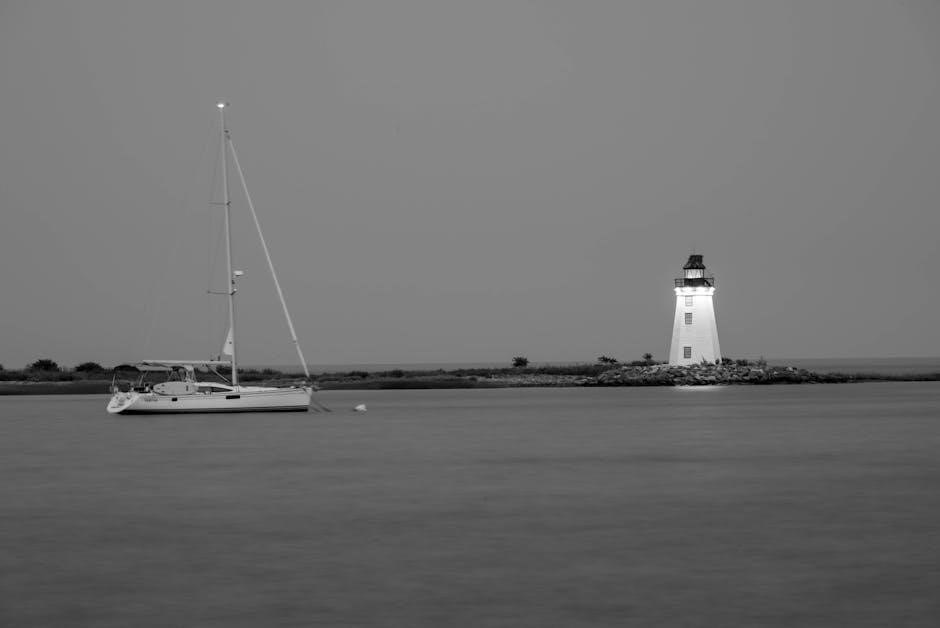
Types of Boat Trailer Bunk Guide-Ons
Boat trailer bunk guide-ons come in various types‚ including carpeted bunk boards‚ PVC guide-ons‚ and roller-style systems‚ each offering unique benefits for trailer alignment and boat protection.
2.1 Carpeted Bunk Boards
Carpeted bunk boards are a popular choice for boat trailers‚ offering a cushioned surface that protects the boat’s hull from scratches and abrasions. The carpet provides a smooth‚ non-abrasive surface for loading and unloading‚ reducing friction and noise. These boards are durable‚ resistant to UV damage‚ and easy to clean‚ making them a practical option for boat owners seeking a balance between protection and affordability. They also help guide the boat into proper alignment during loading.
2.2 PVC Guide-Ons
PVC guide-ons are durable‚ waterproof‚ and resistant to corrosion‚ making them ideal for marine environments. They provide a smooth‚ rigid surface for guiding the boat onto the trailer. PVC guide-ons are easy to clean and maintain‚ offering excellent visibility during loading and unloading. Their lightweight design and affordability make them a popular choice for boat owners seeking a low-maintenance‚ long-lasting solution for their trailer setup.
2.3 Roller-Style Guide-Ons
Roller-style guide-ons feature smooth‚ rotating rollers that assist in guiding the boat onto the trailer. They reduce friction‚ making loading and unloading easier while protecting the boat’s hull from abrasion. Durable and long-lasting‚ rollers are ideal for heavy boats and frequent use. Their ability to pivot ensures proper alignment‚ enhancing safety and convenience for boat owners seeking a reliable and efficient guide-on system.
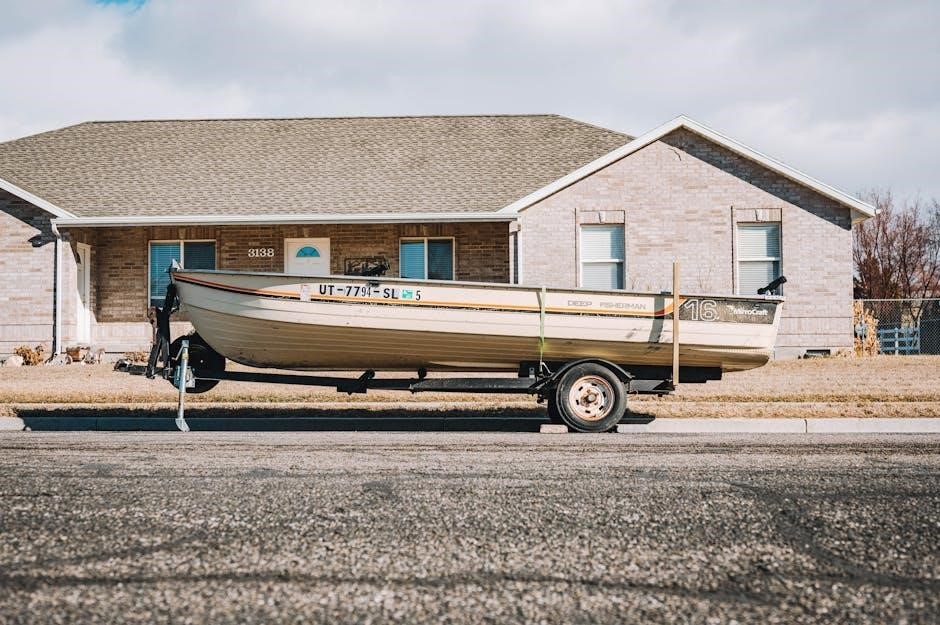
Materials and Construction
Boat trailer bunk guide-ons are crafted from durable materials like marine-grade aluminum and galvanized steel‚ ensuring longevity and strength. Their robust construction withstands harsh marine environments and heavy use.
3.1 Marine-Grade Carpet
Marine-grade carpet is a popular choice for bunk guide-ons due to its durability and water resistance. Designed to withstand harsh marine environments‚ it provides excellent traction‚ preventing boats from slipping during loading or unloading. This carpet is specifically treated to resist mold‚ mildew‚ and UV damage‚ ensuring long-lasting performance. Its soft yet sturdy texture protects the boat’s hull from scratches‚ making it a practical and protective solution for trailer setups.
3.2 Galvanized and Aluminum Components
Galvanized and aluminum components are widely used in boat trailer bunk guide-ons for their exceptional durability and resistance to corrosion. Galvanized steel offers robust protection against rust‚ while aluminum is lightweight and highly resistant to saltwater environments. Both materials are designed to withstand harsh marine conditions‚ ensuring longevity and reliability. They provide strength and stability‚ making them ideal for supporting heavy boat loads during transportation and storage.
Installation and Setup
Proper installation ensures safe and efficient boat loading. Align guide-ons with the trailer’s bunk system‚ secure them tightly‚ and adjust for optimal boat fit and stability.
4.1 Step-by-Step Installation Guide
Begin by measuring and marking the bunk boards for guide-on placement. Attach the guide-ons to the trailer frame using bolts or brackets. Adjust the height and alignment to match your boat’s hull. Tighten all hardware securely. Test the setup by loading the boat slowly‚ ensuring smooth guidance. Make final adjustments for proper fit and stability. Always follow manufacturer instructions for specific installation requirements.
4.2 Tools and Hardware Required
Essential tools include a wrench‚ screwdriver‚ and drill. Hardware needs are bolts‚ brackets‚ and washers. Ensure all components are rust-resistant. Measure and mark accurately. Use a level for proper alignment. Safety gloves and eyewear are recommended. Consult the guide-on kit for specific hardware requirements. Organize tools beforehand to streamline the installation process. Double-check all fasteners for tightness before use.
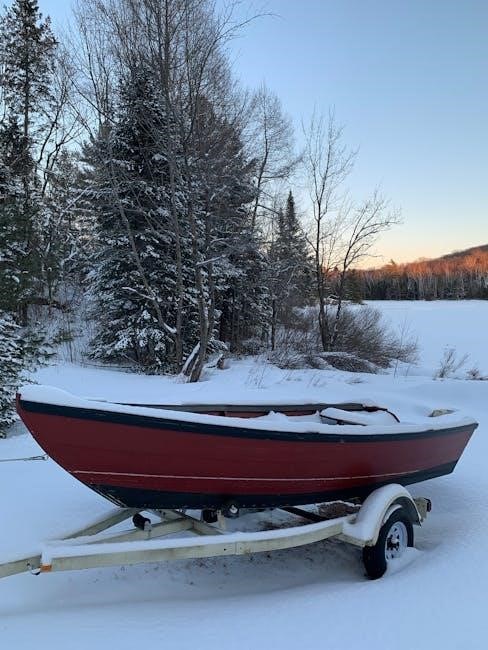
Advantages of Using Bunk Guide-Ons
Bunk guide-ons enhance trailer alignment‚ simplify loading‚ and protect the boat from damage. They improve safety‚ reduce wear and tear‚ and make towing more efficient overall.
5.1 Improved Trailer Alignment
Boat trailer bunk guide-ons significantly enhance trailer alignment by providing a clear visual and physical guide for positioning the boat correctly. This ensures the vessel centers properly on the trailer‚ reducing misalignment issues. Proper alignment minimizes the risk of damage to both the boat and trailer‚ ensuring a secure fit. It also simplifies the loading and unloading process‚ especially for inexperienced users‚ and improves overall towing stability.
5.2 Enhanced Safety During Loading/Unloading
Boat trailer bunk guide-ons enhance safety by stabilizing the boat during loading and unloading‚ reducing lateral movement. This minimizes the risk of accidents‚ such as the boat shifting or sliding off the trailer. The guide-ons act as a protective barrier‚ preventing damage to the vessel and surrounding structures. They also provide clear visual cues‚ helping operators align the boat correctly‚ which reduces the likelihood of injuries or collisions in busy docking areas.
Popular Brands and Manufacturers
GATORBAK is a well-known brand for durable‚ high-quality guide-ons. Other reputable manufacturers include CE Smith‚ Tie Down Engineering‚ and Dutton-Lainson‚ offering reliable solutions for boat trailers.
6.1 GATORBAK
GATORBAK is a leading brand in boat trailer accessories‚ known for its high-quality bunk guide-ons. Their products feature durable materials like marine-grade carpet and robust frames. Designed for smooth boat loading and unloading‚ GATORBAK guide-ons reduce friction and protect the hull. They are popular among boaters for their reliability‚ easy installation‚ and long-lasting performance‚ making them a top choice for enhancing trailer functionality and safety. Their reputation for excellence has made them a trusted name in the industry.
6.2 Other Leading Brands
Besides GATORBAK‚ other reputable brands like CE Smith and Tie Down Engineering offer high-quality bunk guide-ons. These brands are known for their durable materials and innovative designs‚ providing excellent support and alignment for boats. CE Smith’s guide-ons are celebrated for their rust-resistant construction‚ while Tie Down Engineering offers adjustable models for versatility. These brands are trusted by boaters for their reliability and performance‚ ensuring safe and efficient trailer operations.

Compatibility with Different Boat Trailers
Boat trailer bunk guide-ons are designed to fit various trailer types‚ including high beam‚ box‚ and C-channel frames. Adjustable models ensure compatibility with different boat sizes and styles.
7.1 High Beam‚ Box‚ or C-Channel Trailers
High beam‚ box‚ and C-channel trailers are common designs that benefit from bunk guide-ons. These trailers feature sturdy frames‚ making it easier to install guide-ons for alignment. The solid structure ensures a snug fit for guide-ons‚ enhancing boat loading and unloading. Adjustable models can accommodate various trailer widths‚ while fixed styles provide consistent support. Proper mounting ensures durability and performance‚ making them ideal for both small and large watercraft.
7.2 Adjustable Guide-Ons for Versatility
Adjustable guide-ons offer flexibility for various boat and trailer configurations. They allow customization to fit different boat widths and trailer setups‚ ensuring proper alignment. Easy to modify‚ they accommodate boats of varying sizes‚ making them ideal for multi-boat households. Their adaptability enhances loading and unloading efficiency‚ reducing the risk of hull damage. This feature is particularly useful for trailers used with multiple watercraft‚ providing convenience and reliability across different scenarios.
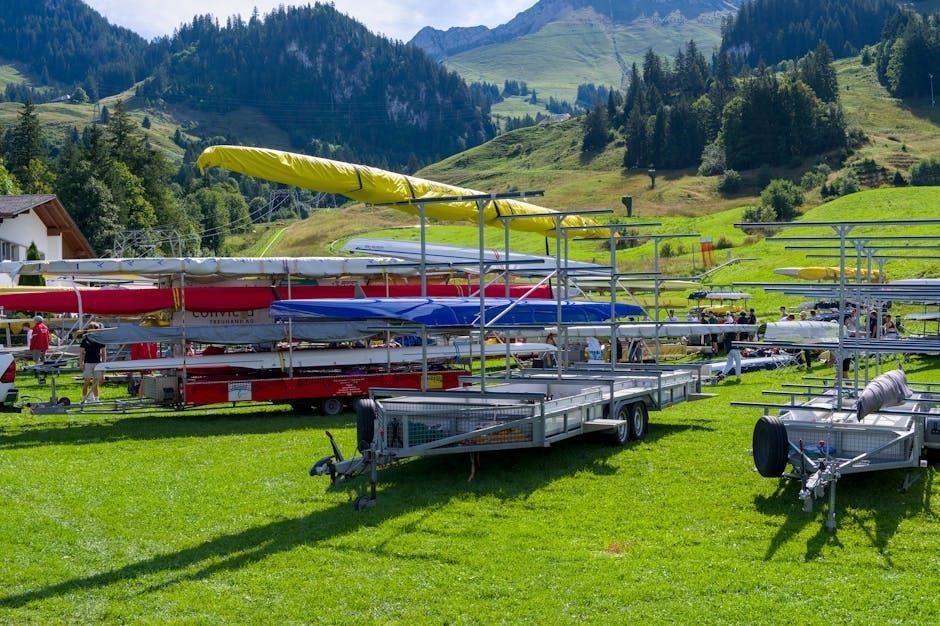
Safety Considerations
Proper use of guide-ons ensures secure boat attachment‚ reducing risks during transport. Regular inspections and maintenance are crucial to prevent accidents and guarantee reliable performance over time.
8.1 Proper Use of Guide-Ons
Proper use of guide-ons involves ensuring they are securely attached to both the trailer and boat. Align the boat with the trailer carefully‚ using the guide-ons to center it. Always maintain a slow speed during loading/unloading to avoid collisions. Regular inspections of the guide-ons for damage or wear are essential. Never overload the system‚ as this can lead to failure. Follow manufacturer guidelines for weight limits and installation. Proper use enhances safety and prevents damage to both the boat and trailer.
8.2 Avoiding Common Hazards
To avoid hazards‚ ensure guide-ons are free from sharp edges that could damage the boat hull. Avoid overloading‚ as excessive stress can cause guide-on failure. Proper alignment during loading/unloading prevents collisions and reduces wear. Regularly inspect for damage or corrosion‚ addressing issues promptly. Keep the system clean to avoid debris buildup. Never exceed manufacturer-recommended weight limits. Environmental factors like UV exposure or rust should be mitigated with proper maintenance. Safety always comes first.

Maintenance and Repair
- Regularly clean guide-ons to prevent dirt buildup.
- Inspect for wear‚ rust‚ or damage; repair promptly.
- Replace worn-out components to maintain functionality.
- Apply protective coatings to extend lifespan.
9.1 Cleaning and Protecting Guide-Ons
Regular cleaning prevents dirt buildup and corrosion. Use fresh water and mild detergent to rinse away debris. Dry thoroughly to avoid rust. For carpeted bunks‚ vacuum and spot clean stains. Protect metal components with a rust-inhibiting spray. Apply UV-protectant sprays to plastic or rubber parts. Lubricate moving parts occasionally. Store guide-ons in a dry place during off-seasons to maintain longevity and performance.
9.2 Repairing Damaged Components
Inspect guide-ons for wear or damage. Replace frayed carpet or cracked PVC. Tighten loose bolts and replace rusty hardware. For roller-style guide-ons‚ lubricate or replace worn rollers. Use marine-grade sealants to protect repaired areas. Addressing issues promptly prevents further damage and ensures safe‚ smooth operation. Regular inspections help maintain functionality and extend the lifespan of your boat trailer bunk guide-ons.
Cost and Value
Boat trailer bunk guide-ons vary in price based on quality‚ brand‚ and features. Investing in durable materials ensures long-term savings and better performance over time.
10.1 Factors Affecting Price
The cost of boat trailer bunk guide-ons is influenced by materials‚ brand‚ and features. High-quality materials like marine-grade carpet or durable PVC increase price. Brand reputation and warranty also impact cost. Adjustable or roller-style guide-ons are typically more expensive than fixed options. Additionally‚ the size of the trailer and compatibility with specific boat types can affect pricing. Customization options may also raise the overall expense.
10.2 Tips for Getting the Best Deal
To get the best deal on boat trailer bunk guide-ons‚ compare prices across retailers and online marketplaces. Consider purchasing during off-season sales or holidays. Check for bundle deals with other trailer accessories. Look for discounts on last year’s models or overstock items. Negotiate with local dealers for better pricing. Reading reviews and product ratings can help identify cost-effective‚ high-quality options that meet your needs without overspending.

Troubleshooting Common Issues
- Misalignment: Adjust guide-ons to ensure proper boat centering.
- Damage: Inspect for wear and replace worn-out components.
11.1 Misalignment Problems
Misalignment issues with boat trailer bunk guide-ons often stem from improper adjustment or uneven wear. This can cause the boat to sit crookedly‚ leading to loading difficulties and potential damage. To fix‚ ensure guide-ons are level and centered. Check for worn components and replace them if necessary. Regularly inspect the bunk boards for proper alignment to maintain smooth operation and prevent further complications during towing and storage.
11.2 Damage to Guide-Ons
Damage to boat trailer bunk guide-ons can occur due to UV exposure‚ abrasion‚ or improper installation. Cracks‚ fraying‚ or bending are common issues. Regular inspections can help identify wear early. Replacing damaged parts promptly prevents further deterioration. Using protective covers and ensuring proper alignment during loading can minimize stress on guide-ons‚ extending their lifespan and maintaining optimal performance for safe and efficient trailering.
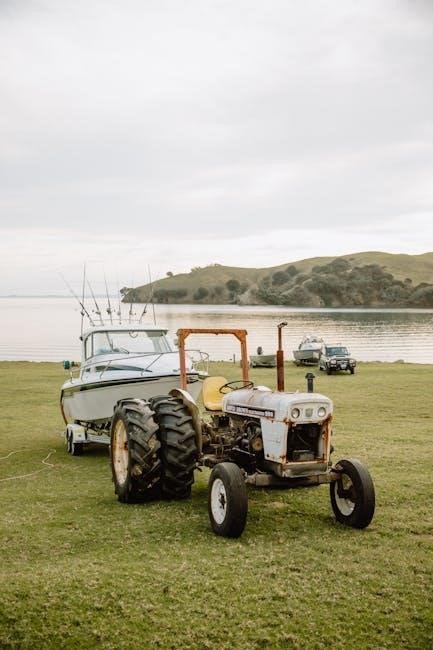
Case Studies and Real-Life Scenarios
Real-life scenarios highlight how guide-ons simplify boat loading and prevent hull damage‚ ensuring safer and more efficient trailering experiences for boat owners.
12.1 Successful Installation Stories
Boat owners have shared numerous success stories about how installing bunk guide-ons transformed their trailering experience. These accessories ensure proper boat alignment‚ reducing wobble and wear during transit. One owner reported easier loading and unloading‚ while another highlighted reduced hull scratches. Proper installation and adjustment are key to maximizing benefits‚ ensuring a safer and more efficient experience for all boat enthusiasts.
- Improved stability during transport.
- Reduced risk of damage to the boat hull.
- Easier alignment for novice users.
- Reduced stress during loading/unloading.
- Protection against accidental hull damage.
- Improved confidence for boat owners.
12.2 Overcoming Loading Challenges
Boat trailer bunk guide-ons have proven invaluable in addressing common loading challenges. By providing clear alignment guidance‚ they simplify the process of positioning the boat onto the trailer. This reduces frustration and minimizes the risk of misalignment. Many users report smoother loading‚ especially in windy or low-visibility conditions. The guides also help prevent hull damage caused by incorrect positioning‚ ensuring a safer and more efficient experience for boat owners of all skill levels.

Future Trends in Boat Trailer Guide-On Technology
Future trends include smart alignment systems with sensors and cameras for real-time feedback‚ eco-friendly materials like recycled plastics‚ and adjustable‚ LED-lit guide-ons for enhanced visibility.
13;1 Innovations in Materials
Future innovations in materials for boat trailer bunk guide-ons focus on durability and sustainability. Marine-grade recycled plastics are gaining traction‚ offering UV resistance and reduced environmental impact. Additionally‚ lightweight yet robust composites‚ such as graphene-based materials‚ are being explored to enhance strength and corrosion resistance. These advancements aim to provide longer-lasting‚ low-maintenance solutions while minimizing ecological footprint‚ ensuring guide-ons perform optimally in harsh marine environments.
13.2 Smart Alignment Systems
Emerging smart alignment systems integrate sensors and cameras to assist with precise trailer and boat alignment. These systems provide real-time feedback‚ reducing misalignment issues during loading and unloading. Advanced models offer automated adjustments‚ enhancing ease of use and safety. Such innovations streamline the process‚ minimizing the risk of damage to both the boat and trailer.
These systems also minimize wobble and improve stability‚ ensuring a smoother towing experience. By integrating with bunk guide-ons‚ they enhance overall efficiency and user confidence‚ representing a significant leap forward in trailer technology.
Boat trailer bunk guide-ons are essential for safe and efficient boat handling‚ offering alignment‚ protection‚ and convenience. Investing in high-quality guide-ons ensures durability and enhances your boating experience.
14.1 Final Thoughts on Boat Trailer Bunk Guide-Ons
Boat trailer bunk guide-ons are a crucial investment for any boat owner‚ enhancing safety‚ efficiency‚ and convenience during loading and unloading. They protect your boat from damage‚ improve alignment‚ and withstand harsh marine conditions. With proper maintenance‚ guide-ons provide long-lasting performance. Whether you’re a seasoned boater or a newcomer‚ high-quality guide-ons are a smart choice to ensure your boating adventures remain smooth and stress-free for years to come.
14.2 Encouragement to Invest in Quality Guide-Ons
Investing in high-quality boat trailer bunk guide-ons is a wise decision for boat owners. They offer long-term durability‚ reducing wear and tear on your boat and trailer. Quality guide-ons also enhance safety and efficiency during loading and unloading. While they may cost more upfront‚ their reliability and performance make them a valuable long-term investment for protecting your boat and ensuring hassle-free boating experiences.
